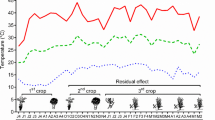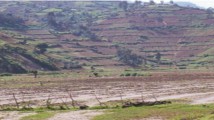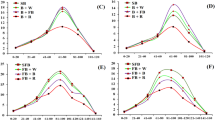Abstract
Gliricidia sepium is a fast growing legume shrub or tree with a wide range of environmental adaptation. Pruning of bushes at 1 m tall provides a source of crop nutrients. However, the value of pruning for increased agricultural productivity is not fully known. A study was carried out in a high rainfall humid tropical environment to investigate the contribution of Gliricidia sepium prunings (leaves and roots) and subsequent fallow with prunings to nitrogen (N) release pattern, sweet corn yield, nitrogen uptake and the N use efficiency (NUE) of the prunings. 15N atom excess dilution and litter bag incubation techniques were used to partition N uptake and estimate N-release pattern of the leaves and roots. The prunings were applied as smooth stems and leaves at a rate of 120 kg N/ha in two split applications, 7–30 days after sweet corn germination. The crop was harvested after 75 days at the physiological maturity. The results showed that Gliricidia Sepium leaves and roots significantly (p ≤ 0.05) increased sweet corn dry matter yield (3158 kg/ha) over the control (898 kg/ha). However, this was not significantly different from those treatments with leaf or root prunings in the presence of hedgerows. Use of root prunings as fallow showed significantly (p ≤ 0.05) higher sweet corn dry matter (2175 kg/ha) yield than that (1082 kg/ha) obtained from leaf prunings application. Nitrogen partition using 15N atom excess dilution showed that Gliricidia sepium fallow and leaf prunings contributed 25.9% and over 100% of total sweet corn N uptake and yield (as total dry matter), respectively. The incubation experiment showed that Gliricidia sepium leaves mineralize very fast, faster than roots, and should be re-applied within 20 days to maintain N-supply from the leaf prunings. It was concluded that Gliricidia sepium pruning and fallow contribute to the N uptake, growth and yield of the sweet corn with 5–9% NUE of the prunings. Further research is required to increase N use efficiency of Gliricidia sepium prunings and fallow in this study environment.
Access this chapter
Tax calculation will be finalised at checkout
Purchases are for personal use only
Similar content being viewed by others
References
Akinnifesi, F. K., Makumba, W., & Kwesiga, F. R. (2006). Sustainable maize production using Gliricidia/maize intercropping in southern Malawi. Experimental Agriculture, 42(4), 441–457.
Amara, S. D., Sanginga, N. S., Danso, S. K. A., & Suale, D. S. (1996). Nitrogen contribution by multipurpose trees to rice and cowpea in alley cropping system in Sierra Leone. Agroforestry Systems, 34(2), 119–128.
Barreto, A. C., Chaer, G. M., & Fernandes, M. F. (2012). Hedgerow pruning frequency effects on soil quality and maize productivity in alley cropping with Gliricidia Sepium in Northeastern Brazil. Soil and Tillage Research, 120, 112–120.
Barrios, E., Buresh, R. J., & Sprent, J. I. (1996). Organic matter in soil particle size and density fractions from maize and legume cropping systems. Soil Biology and Biochemistry Journal, 28(2), 185–193.
Barrios, E., Kwesiga, F., Buresh, R. J., Coe, R., & Sprent, J. I. (1998). Relating preseason soil nitrogen to maize yield in tree legume-maize rotations. Soil Science Society of America Journal, 62(6), 1604–1609.
Bremner, J.M. (1965). Total nitrogen. In C.A. Black, D.D. Evans, L.E. Ensminger, L.E., White, J.L., Clark, F.E., & Dinauer, R.C. (Eds). Methods of soil analysis Part 2.
Buresh, R. J., & Tian, G. (1997). Soil improvement by trees in Sub-Sahara Africa. Agroforestry Systems, 38, 51–76.
Danso, S. K. A., Bowen, G. D., & Sanginga, N. (1992). Biological Nitrogen fixation in trees in agro-ecosystems. Plant and Soil, 141, 177–196.
Elevitch, C.R., & Francis, J.K. (2006). Species profiles for Pacific Island agroforestry. Ver. 2.1, 1–18. Available at: www.traditionaltree.org. Accessed August 2018.
Hall, N. M., Kaya, B., Dick, J., Skiba, U., Niang, A., & Tabo, R. (2006). Effect of improved fallow on crop productivity, soil fertility and climate-forcing gas emissions in semi-arid conditions. Biology and Fertility of Soils, 42(3), 224–230.
Hartemink, A. E., & O’Sullivan, J. N. (2001). Leaf litter decomposition of Piper aduncum, Gliricidia sepium and Imperata cylindrica in the humid lowlands of Papua New Guinea. Plant and Soil, 230(1), 115–124.
Ikerra, S. T., Maghembe, J. A., Smithson, P. C., & Buresh, R. J. (1999). Soil nitrogen dynamics and relationships with maize yields in a Gliricidia-maize intercrop in Malawi. Plant and Soil, 211, 155–164.
ILCA. (1991). Methods of soil analysis Part 3. Chemical methods. Working document 13, ILCA, Addis Ababa, Ethiopia. [NB: This working document was later published later in 1996 as SSSA Book series 5.3]. USA, WI: Soil Science Society of America, American Society of Agronomy.
Jama, B., Niang, A.I., Amadolo, B., Wolf, J., Rao, M.R., & Buresh, R.J. (1998). The potential of planted fallows to improve and conserve the fertility of nutrient-depleted soils of western Kenya. In Proceedings of the 6th KARI Scientific Conference, Nairobi, November 9–13, 1998 (pp. 133–144). Nairobi: Kenya Agricultural Research Institute.
Kadiata, B. D., & Mulongoy, K. (1995). Early nitrogen fixation and utilization in Albizia Lebbeck, Leucaena Leucocephala and Gliricidia Sepium using nitrogen (15N) labelling. Communications in Soil Science and Plant Analysis, 26(9/10), 1397–1409.
Kathuli, P., Gachimbi, L.N., Maingi, S.W., & Thuranira, E.G. (2007). Suitability of modified dilute double acid-Mehlich 1 (0.1NHCL + 0.025NH2SO4) and Olsen (0.5MNaHCO3 PH 8.5) methods for testing of available phosphorus for Kenyan soils. Discovery and Innovation, Journal of the African Academy of Sciences and the Academy for the Developing World, 19(3), 195–201.
Martins, J. C. R., Freitas, A. D. S., Menezes, R. S. C., & Sumpaio, E. V. S. (2015). Nitrogen symbiotically fixed by cowpea and Gliricidia sepium in traditional and agroforestry systems under semi-arid conditions. Pesquisa Agropecuária Brasileira, 50(2), 178–184.
Matilda, A. (2009). Effect of Gliricidia Sepium and Senna Siamea pruning on the growth and root yield of cassava. MPhil. Thesis submitted to the School of Postgraduate Studies, Kwame Nkrumah University of Science and Technology.
Mekonnen, K., Buresh, R. J., & Jama, B. (1997). Root and inorganic nitrogen distributions in Sesbania fallow, natural fallow and maize fields. Plant and Soil, 188(2), 319–327.
Palm, C. A. (1995). Contribution of agroforestry trees to nutrient requirements of inter-cropped plants. Agroforestry Systems, 30, 105–124.
Rittenberg, D., Keston, A. S., Rosebury, K. F., & Schoenheimer, B. (1939). Studies in protein metabolism. II. The determination of nitrogen isotopes in organic compounds. Journal of Biological Chemistry, 127, 291–299.
Sáez-Plaza, P., Navas, M.J., Wybraniec, S., Michalowski, T., & Asuero, A.G. (2013). An overview of the Kjeldahl method of nitrogen determination. Part II. Sample preparation, working scales, instrumental finish, and quality control. Critical Reviews in Analytical Chemistry, 43, 224–272. Taylor and Francis.
Schwendener, C. M., Lehmann, J., de Camargo, P. B., Luizão, R. C. C., & Fernandes, E. C. M. (2005). Nitrogen transfer between high- and low- quality leaves on a nutrient- poor Oxisol determined by 15N enrichment. Soil Biology & Biochemistry, 37(4), 787–794.
Srinivasa Rao, Ch., Venkateswarlu, B., Dinesh Babu, M., Wani, S. P., Dixit, S., Sahrawat, K. L., & Sumanta K. (2011). Soil health improvement with Gliricidia green leaf manuring in rainfed agriculture, on farm experiences. Technical bulletin 2/2011. Central Research Institute for Dry land Agriculture (ICAR).
USDA. (1975). Soil taxonomy. A basic system of soil classification for making and interpreting soil surveys. Agriculture Handbook 436. Washington DC, USA: Soil Conservation Service, US Department of Agriculture (USDA).
Zaharah, A. R., Sharifuddin, H. A. H., & Anuar, R. (1996). Field measurements of N2 fixation by Gliricidia Sepium. In O. Van Cleemput, G. Hofman, A. Vermoesen (Eds.). Progress in nitrogen cycling studies. Proceedings of the 8th Nitrogen Workshop held at the University of Ghent, 5–8 September, 1994 (pp. 321–326). Developments in Plant and Soil Sciences, 68. Dordrecht: Springer Netherlands.
Zapata, F. (1990). Isotope techniques in soil fertility and plant nutrition studies. In G. Hardarson (Ed.) Use of nuclear techniques in studies of soil-plant relationships (pp. 61–127). Training course series No. 2. Vienna: International Atomic Energy Agency (IAEA).
Acknowledgements
The United Nations Development Programme (UNDP) and the International Atomic Energy Agency (IAEA) acknowledged for funding the project. Professor Zaharah of Universiti Putra Malaysia (UPM) is thanked for supervising the first author on use of isotopes in soil fertility studies. Thanks are also given to the Director Kenya Agricultural Research Institute (KARI) (now the Kenya Agricultural and Livestock Research Organization [KALRO]) for granting leave to study in Malaysia and to the technicians at UPM Soil Science Department for their assistance in soil analysis.
Author information
Authors and Affiliations
Corresponding author
Editor information
Editors and Affiliations
Rights and permissions
Copyright information
© 2020 Springer Nature Switzerland AG
About this chapter
Cite this chapter
Kathuli, P., Zaharah, A.R., Nguluu, S.N. (2020). Contribution of Gliricidia sepium Pruning and Fallow to Sweet Corn (Zea mays L. var. rugosa) Yield, Nitrogen Uptake, Release Pattern and Use Efficiency in a Humid Tropical Environment of Malaysia. In: Sutton, M.A., et al. Just Enough Nitrogen. Springer, Cham. https://doi.org/10.1007/978-3-030-58065-0_16
Download citation
DOI: https://doi.org/10.1007/978-3-030-58065-0_16
Published:
Publisher Name: Springer, Cham
Print ISBN: 978-3-030-58064-3
Online ISBN: 978-3-030-58065-0
eBook Packages: Earth and Environmental ScienceEarth and Environmental Science (R0)




